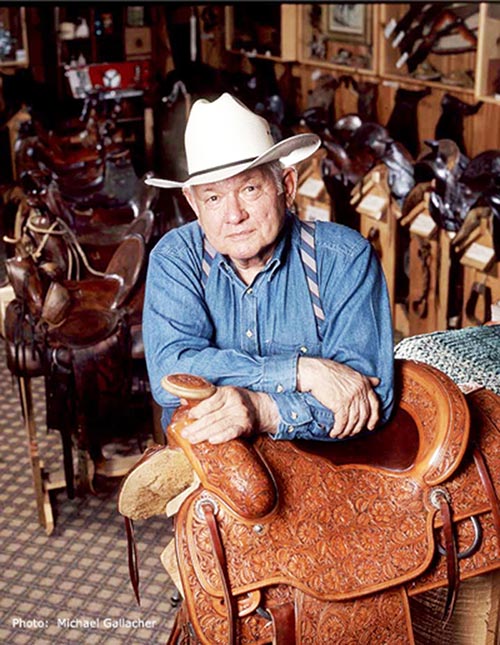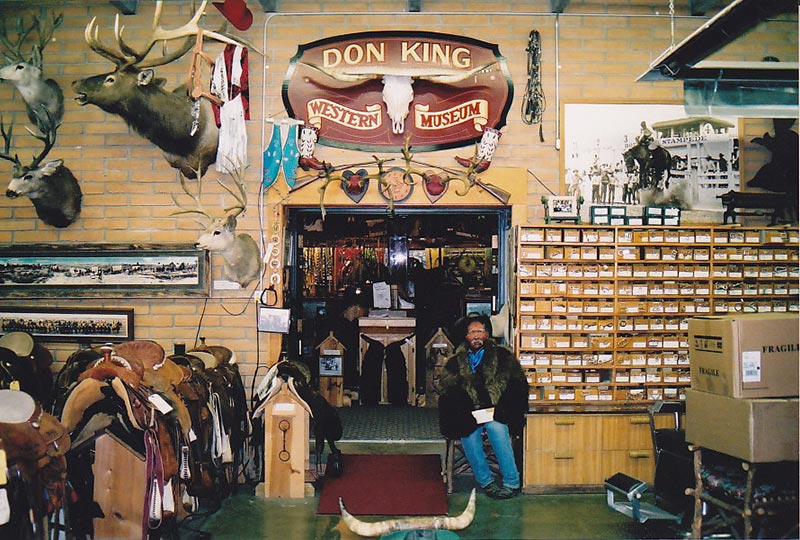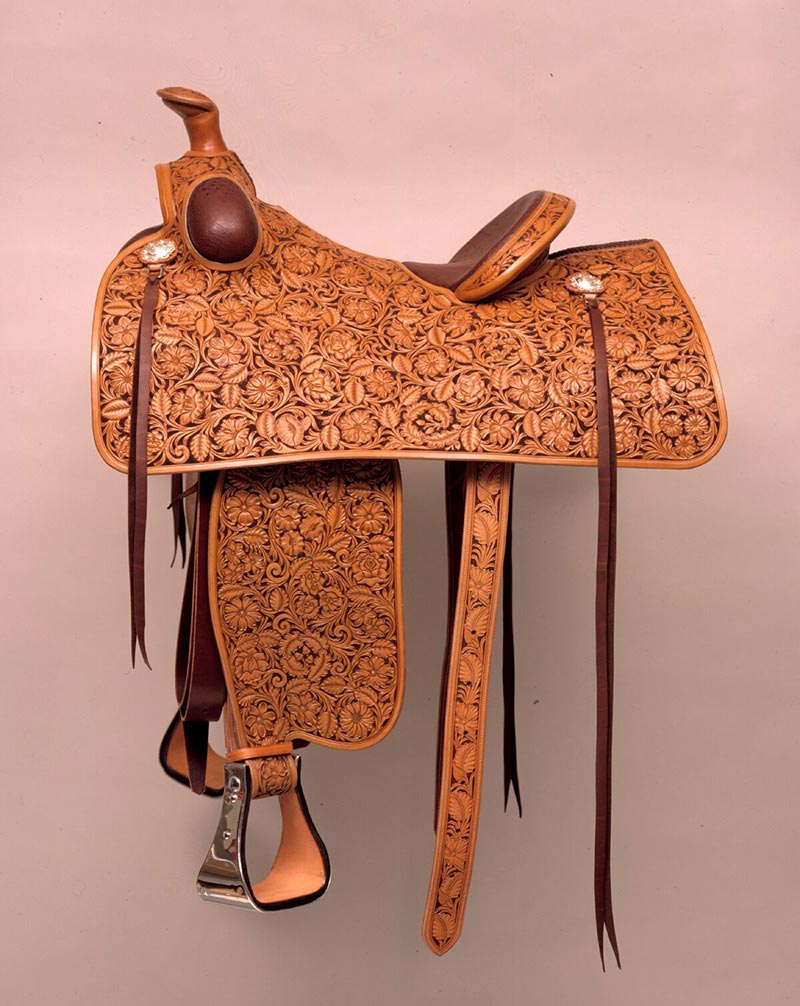
by Nick Pernokas
They say that a good writer should never interject himself into his stories. They say a lot of things. When dealing with “legends” of the West, they say when the legend outshines the fact, print the legend. Only sometimes, you don’t have to and this is one of those times. Most of the story that I’m going to tell you came from Don King, in his own words, over a cup of coffee in 2005. The rest came from his friends who knew him best over the course of his life. And now, you’ll know him as well.
Don was the grandson of a cowboy who went up the trail with the herds eight times from Texas in the late 1800’s. Don was born in Douglas, Wyoming, in 1923, and his parents divorced when he was five years old. His father, Arch, was an itinerant cowboy and Don was raised on the road, sometimes spending only a couple of months at one ranch, before moving on to the next. The next few years were spent in Arizona. Sometimes Don would live in the bunkhouse with his dad and sometimes he would be boarded out so he could go to school. Later they would cowboy in Wyoming in the summers, and spend the winters in Arizona or California. Arch was a horse breaker and he would hire on to ride the rough string and get them broke for the other cowboys.
Although Don did okay in school, the gypsy life was hard on his education. In high school, he dropped out and went to work for a boarding stable in Phoenix. In his spare time, he’d go in and visit the stampers and saddle makers at Porters Saddle Shop. The work fascinated him, but most of the old timers in the shops he’d visited didn’t really want to teach a kid leatherwork. At Porters, his persistence paid off.
A young saddle maker named Cliff Ketchum told Don to get some leather scraps and showed him how to make stamping tools from nails. Don even made some stamps from wood and a simple swivel knife. It was simply a blade pushed into the bottom of a twig, with a piece of tin on the top for a yoke. A nail held the tin on and allowed the yoke to turn. From then on, Don couldn’t wait for some time off to indulge in his hobby. Eventually, he was stamping belts for shops in the towns where he was cowboying. His first large order came while he was working for a ranch in Palm Springs. The owner of New York’s famed 21 Club was vacationing there, and impressed with King’s work, he bought 24 belts to take back to his employees.

In 1941, while Don was breaking horses for a guest ranch in Wolf, Wyoming, he met Dorothy Clapp at a social function. In 1943, they were married. This was also the year that Don joined the Coast Guard. He had hoped to be assigned to a horse patrol. After boot camp, he heard of an opening in Fort Robertson, Nebraska. Don knew this was an old remount station that had 12,000 horses before the war. When Don arrived, he was disappointed to find out that it was a dog patrol unit; they were feeding the horses to the dogs.
Don’s service included duty on the Gulf and the West Coast; he also made a couple of trips to the Philippines. In 1945, the war ended and his first son, Bill, was born. Three more boys – Bruce, Bob and John came along later.
When Don returned from World War II, he had several stamping jobs waiting for him. He and his wife settled in Sheridan, Wyoming, where the post-war boom was keeping several saddle shops busy. He went to work for Rudy Mudra, on the condition that he could learn to build saddles. Mudra was a good teacher and had worked as a saddle maker for Miles City Saddlery in their heyday; Don had stamped belts for him before the War.
Don said, “After a year, I decided I knew it all and went out on my own.”
This was the start of Don’s first shop in 1947. In 1949, the call of his previous occupation became too strong, so he bought some acreage and began ranching. With too many irons in the fire, he closed his shop. Over the next few years, Don worked periodically for Mudra, as well as Otto Ernst Saddlery. In 1959, he received a contract to make the Rodeo Cowboys Association World Championship saddles. He was enthused by being able to make these saddles as nice as he wanted to. He continued making them until 1966, and the publicity they generated propelled him into the public eye outside of cowboy country.
In 1961, Don opened his second shop across from his current location. Business boomed and soon Don was way behind in his saddle orders. Don worked nights when it was quiet, and pushed all the time. Finally, there came a day in 1968 when one order too many broke the camel’s back.
Don said, “I burned out on saddles twice. I had a 150 orders for me (personally) and I just canceled everything.”

Fortunately for ropers, this was a boost to King Ropes, which had become its own business in 1967, and Don jumped into the rope business all the way. At this time, many ropers still tied and stretched their own ropes. Don had been providing a service by doing it for them, and now he began promoting the idea of ready-to-use, pre-stretched lariats. Only a couple of other rope makers were selling the finished ropes at that time. Starting out with nylon ropes for team ropers, King added grass ropes for calf ropers. Soon they were twisting their own ropes, and as more synthetic fibers became available, Don would try them out.
“That’s the way I am about everything,” said Don, “I like to experiment. I miss it.”
Eventually his sons got involved: Bobby ran the rope department, Bruce worked on the business end of things, John became the head saddle maker, but Bill, an accomplished leather tooler, would leave the family business for real estate.
Most of the saddles built at King’s Saddlery in the 60s and 70s, were geared toward the calf ropers and steer ropers. They were full double-rigged, with a swell to lean on and a moderate cantle. The skirts had a contemporary, square look to them. In recent years, the slick fork saddles with plate riggings became popular, and King’s Saddlery turned out saddles on Wade-style trees too. Don thought that revolving saddle fashions were good and generated sales.
Another period of burnout led Don into a new venture – he started making leather tools at his shop on the ranch for the public. They were popular and soon he found himself behind again.
Over the years, King’s took a lot of trade-ins on new saddles. Some of these old saddles were antiques with a lot of history. Don liked to collect old saddles and other historical items, but never had a place to put them. In 1989, a furniture warehouse in back of King’s Saddlery came up for sale, and it became The Don King Museum. Today, it is overflowing with saddles from every time period and weapons, tack, saddle making tools and memorabilia from all over the West.

Don’s tooling has been called the origin of the “Sheridan Style.” He thought that his style was a mixture of the Porters, Visalia and Lloyd Davis styles. He believed that the trend towards smaller tooling, which he had started in his trophy saddles, may not have been better, but it had a higher degree of difficulty and demonstrated a willingness to spend the extra time on it.
All of the sons had an interest in roping, or rodeo, and a background in the business. John, a former high school champion cowboy, seemed to be stepping into Don’s footsteps. This soft-spoken, saddle maker was creating beautiful saddles from his shop in the basement of the store. In 2001, he died unexpectedly, leaving a void in the shop. A couple of years later, Bob, a roper who loved the rope business, passed away from cancer. These were devastating blows to the Kings, and could have been to the business, but fortunately they were surrounded by loyal employees who had been there a long time.
Three of King’s premier leatherworkers were James Jackson, Clint Gibson and Link Weaver and they were able to keep the leather department going. Gary Mefford and Dan Morales, both long time King employees, kept the rope department going.
By 2005, Don, an emeritus member of the Traditional Cowboy Arts Association, had standing invitations for his work at several prestigious western art shows, including the TCAA functions. Don had been awarded the Chester A. Reynolds Award from the National Cowboy and Western Heritage Hall of Fame, as well as an Academy of Western Artists, Saddle Maker of the Year Award. He found it difficult, however, to sit down and get a saddle turned out after all the years and saddles. Don said, “I’m supposed to be retired, but I have more to do than I’ve ever had.”
Don influenced many of the up-and-coming saddle makers in the Sheridan area. Bill Gardner, Bob Douglas, Don Butler and Chester Hape all worked for, or with Don, and were greatly influenced by him. All of these men became the spearhead of what is known as the Sheridan Style of carving leather.
Bill Gardner, one of the authors of Sheridan Style Carving, met Don when Don was an 18-year-old horse breaker, and he was just a young boy. Bill credited Don with teaching him to tool, as well as build tools, at night in the ranch bunkhouse. From 1945 until 1985, Bill worked with and for Don a number of times.
In 2005, Bill said, “I’ve quit King’s a half dozen times. We’d get in a ‘cuss fight’ and I’d walk off. We’ve always been good friends through all that and still are.” The award-winning saddle maker, Don Butler, also credited Don as being a major source of inspiration. Chester Hape, famed for the many PRCA World Championship saddles that he made, built his first two saddles under Don King’s tutelage.

“I learned everything from King,” reflects Bob Douglas. Today, Bob is well known for Douglas Tools, a line of high-quality, specialized leather tools. At 24, he went to work for King’s Saddlery, while also cowboying in the summers. A broken hip from a horse fall sidelined Bob for a while, and since he was hanging out in the saddle shop already, Don put him to work. For the next seven winters, from October to April he worked at King’s.
“Don had a lot of inspirational ideas of his own and this is what evolved into the Sheridan Style of leather tooling,” continues Bob. “A lot of the tools that he needed for his style of stamping weren’t out there, so he made them. Now a lot of toolmakers have been able to duplicate Don’s tools and made them available to other craftsmen.”
Leatherworkers have argued for years about what constituted the Sheridan Style. It can definitely be said that it was a refinement of leather carving that celebrated tighter and more intricate patterns. The knowledge and tools that were developed in Sheridan are what’s important. They spread like ripples and have become not just an end, but a stepping stone in the evolution of leather as art.
The man at the center of these ripples would probably have had a chuckle at the self-important sound of that last statement; his sense of humor did not let him take himself that seriously. When we finished our cups of coffee, Don headed towards the rope department to see an old friend.
On July 28, 2007, Don King passed away.
To find out more about King’s Saddlery, Kings Ropes or The Don King Museum, go to www.kingssaddlery.com or call 800-443-8919.
King’s Saddlery
King Ropes
184 N. Main Street
Sheridan, Wyoming 82801
This article is originally published on www.shoptalk-magazine.com and re-published here with permission.
































